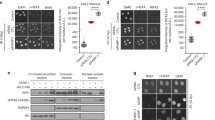Abstract
Recent evidence obtained with transgenic knockout mice suggests that the enzyme poly(ADP-ribose)polymerase (PARP) does not play a direct role in DNA break processing [1, 2]. Nevertheless, inactivation of the catalytic or the DNA nick-binding functions of PARP affects cellular responses to genotoxins at the level of cell survival, sister chromatid exchanges and apoptosis [2, 3]. In the present report, we conceptualize the idea that PARP is part of a DNA break signal mechanism [4, 5]. In vitro screening studies revealed the existence of a protein family containing a polymer-binding motif of about 22 amino acids. This motif is present in p53 protein as well as in MARCKS, a protein involved in the regulation of the actin cytoskeleton. Biochemical analyses showed that these sequences are directly targeted by PARP-associated polymers in vitro, and this alters several molecular functions of p53- and MARCKS protein. PARP-deficient knockout mice from transgenic mice were found to exhibit several phenotypic features compatible with altered DNA damage signaling, such as downregulation and lack of responsiveness of p53 protein to genotoxins, and morphological changes compatible with MARCKS-related cytoskeletal dysfunction. The knockout phenotype could be rescued by stable expression of the PARP gene. - We propose that PARP-associated polymers may recruit signal proteins to sites of DNA breakage and reprogram their functions.
Similar content being viewed by others
References
Wang ZQ, Auer B, Stingl L, Berghammer H, Haidacher D, Schweiger M, Wagner EF: Mice lacking ADPRT and poly(ADP-ribosyl)ation develop normally but are susceptible to skin disease. Genes Dev 9: 509–520, 1997
Ménissier-de Murcia J, Niedergang C, Trucco C, Ricoul M, Dutrillaux B, Marks M, Oliver FJ, Masson M, Dierich A, LeMeur M, Walztinger C, Chambon P, de Murcia G: Requirement of poly(ADP-ribose) polymerase in recovery from DNA damage in mice and in cells. Proc Natl Acad Sci USA 94: 7303–7307, 1997
Schreiber V, Hunting D, Trucco C, Gowans B, Grunwald D, de Murcia G, Ménissier-de Murcia J: Dominant-negative mutant of human poly(ADP-ribose)polymerase affects cell recovery, apoptosis, and sister chromatid exchange following DNA damage. Proc Natl Acad Sci USA 92: 4753–4757, 1995
Lindahl T, Satoh MS, Poirier GG, Klungland A: Posttranslational modification of poly(ADP-ribose)polymerase induced by DNA strand breaks. Trends Biochem Sci 20: 405–411, 1995
Althaus FR: Role of poly(ADP-ribose)polymerase in base excision repair. In: J.D. Hickson (ed) Base Excision Repair of DNA Damage. Springer/Landes Bioscience, Austin TX, 1997, pp. 169–181
Althaus FR: Poly ADP-ribosylation: A histone shuttle mechanism in DNA excision repair. J Cell Sci 102: 663–670, 1992
Mathis G, Althaus FR: Uncoupling of DNA excision repair and nucleosomal unfolding in poly (ADP-ribose)-depleted mammalian cells. Carcinogenesis 13: 135–138, 1990
Reed M, Woelker B, Wang P, Anderson MA, Tegtmeyer P: The C-terminal domain of p53 recognizes DNA damaged by ionizing radiation. Proc Natl Acad Sci USA 92: 9455–9459, 1995
Jackson SP, Jeggo PA: DNA double-strand break repair and V(D)J recombination: Involvement of DNA-PK. Trends Biochem Sci 20: 412–415, 1995
De Murcia G, Ménissier-de Murcia J: Poly(ADP-ribose)polymerase: A molecular nick sensor. Trends Biochem Sci 19: 172–176, 1994
Bargonetti J, Friedman PN, Kern SE, Vogelstein B, Prives C: Wild-type but not mutant p53 immunopurified proteins bind to sequences adjacent to the SV40 origin of replication. Cell 65: 1083–1091, 1991
Niewolik D, Vojtesek B, Kovarik J: p53–derived from human tumour cell lines and containing distinct point mutations can be activated to bind its consensus target sequence. Oncogene 10: 881–890, 1995
Malanga M, Bachmann S, Panzeter PL, Zweifel B, Althaus FR: Poly(ADP-ribose) quantification at the fentomol level in mammalian cells. Anal Biochem 228: 245–251, 1995
Kaiser P, Auer B, Schweiger M: Inhibition of cell proliferation in Saccharomyces cerevisiae by expression of human NAD-ADPribosyltransferase requires the DNA binding domain ('zinc finger'). Mol Gen Genet 232: 231–239, 1992
Panzeter PL, Zweifel B, Malanga M, Waser SH, Richard MC, Althaus FR: Targeting of histone tails by poly(ADP-ribose). J Biol Chem 268: 17662–17664, 1993
Jayaraman L, Prives C: Activation of p53 sequence-specific DNA binding by short single strands of DNA requires the p53 C-terminus. Cell 81: 1021–1029, 1995
Panzeter P, Realini C, Althaus FR: Noncovalent interactions of poly(adenosine diphosphate ribose) with histones. Biochemistry 31: 1379–1385, 1992
Malanga M, Pleschke JM, Kleczowska HE, Althaus FR: Poly(ADPribose) binds to specific domains of p53 and alters its DNA binding functions. J Biol Chem 273: 11839–11843, 1998
Bakalkin G, Selivanova G, Yakovleva T, Kiseleva E, Kashuba E, Magnusson KP, Szekely L, Klein G, Terenius L, Wiman KG: p53 binds single-stranded DNA ends through the C-terminal domain and internal DNA segments via the middle domain. Nucleic Acids Res 23: 362–369, 1995
Aderem AA: The MARCKS brothers: A family of protein kinase C substrates. Cell 71: 713–716, 1992
Hartwig JH, Thelen M, Rosen A, Janmey PA, Naim AC, Aderem AA: MARCKS is an actin filament crosslinking protein regulated by protein kinase C and calcium-calmodulin. Nature 356: 618–622, 1992
Shin I, Kam Y, Ha KS, Kang K, Joe CO: Inhibition of the phosphorylation of a myristoylated alanine-rich C kinase substrate by methyl methanesulfonate in cultured MH 3T3 cells. Mutat Res 351: 163–171, 1996
Li X, Coffino P: Identification of a region of p53 that confers lability. J Biol Chem 271: 4447–4451, 1996
Althaus FR, Richter C: ADP-ribosylation of proteins. Mol Biol Biochem Biophys 37: 1–125, 1987
Kleczkowska HE, Althaus FR: Response of human keratinocytes to extremely low concentrations of N-methyl-N′-nitro-N-nitrosoguanidine. Mutat Res 367: 151–159, 1996
Wesierska-Gadek J, Bugajaska-Schretter A, Cemi C: ADP-ribosylation of p53 tumor suppressor protein: Mutant but not wild-type p53 is modified. J Cell Biochem 62: 90–101, 1996
Mendoza-Alvarez H, Alvarez-Gonzalez R: Poly(ADP-ribose) polymerase is a catalytic dimer and the automodification reaction is intermolecular. J Biol Chem 268: 22575–22580, 1993
Panzeter P L, Althaus F R: DNA strand break-mediated partitioning of poly(ADP-ribose)polymerase function. Biochemistry 33: 9600–9605, 1994
Author information
Authors and Affiliations
Rights and permissions
About this article
Cite this article
Althaus, F.R., Kleczowska, H.E., Malanga, M. et al. Poly ADP-ribosylation: A DNA break signal mechanism. Mol Cell Biochem 193, 5–11 (1999). https://doi.org/10.1023/A:1006975002262
Issue Date:
DOI: https://doi.org/10.1023/A:1006975002262




